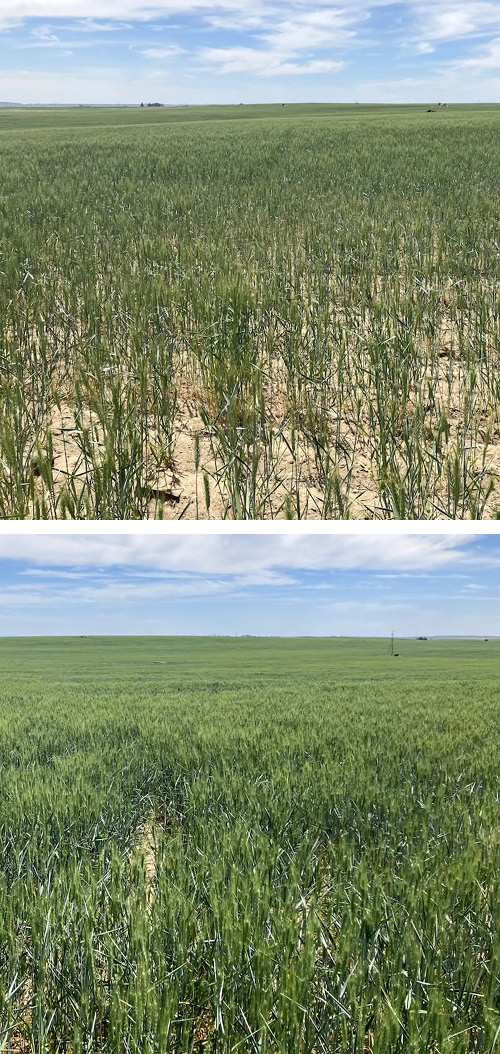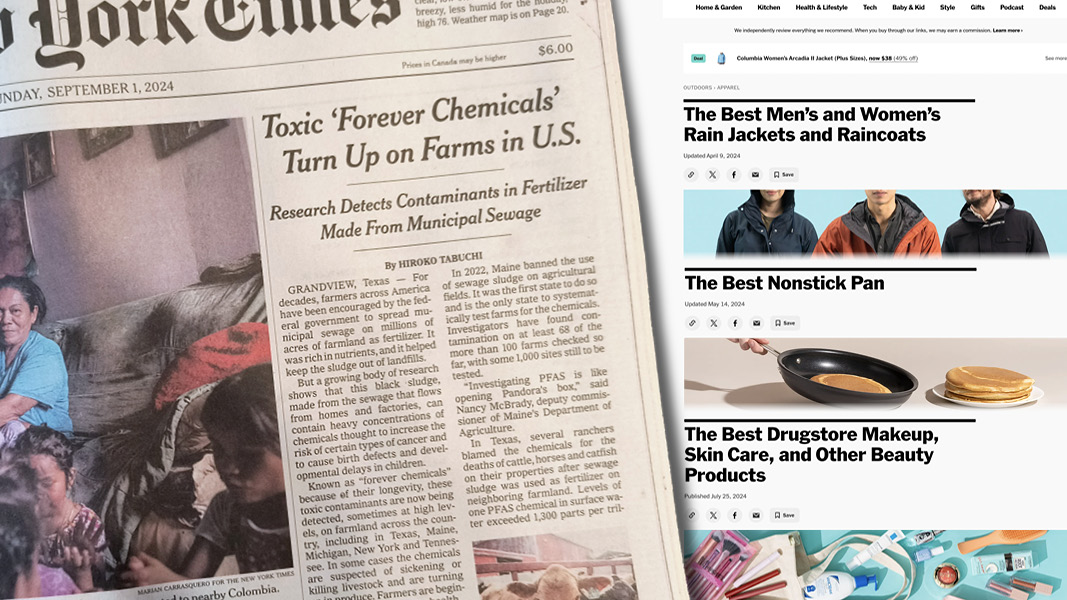Top: A snapshot of The New York Times September 1, 2024 front page (print edition) contrasted with examples of products reviewed/recommended in the New York Times’ “Wirecutter” serves to illustrate the huge disconnect between a fear mongering headline and products we all purchase and welcome into our lives. Images/content ©The New York Times
 Sally Brown
Sally Brown
I start every morning the same way: my latte and Wordle. I haven’t figured out how to go directly to the games section of the New York Times (NYT) and so am forced to start on the home page. And so, on Saturday, staring me right in the face was the screaming headline, “Something’s Poisoning America’s Land. Farmers Fear ‘Forever’ Chemicals” (Tabuchi, 2024). The deck of the headline read, “Fertilizer made from city sewage has been spread on millions of acres of farmland for decades. Scientists say it can contain high levels of the toxic substance.”
I have to admit that I needed to do not only Wordle but Connections and the Mini to get the wherewithal to actually read the article. And as with so much in the NYT these days it really did disappoint. Rather than presenting a balanced article focusing on human exposure to PFAS (if that is what you are looking for I’d highly recommend this piece in ProPublica), the article focused on that tiny intersection of municipal wastewater and PFAS contamination.
Let’s start with the article in ProPublica. It points out that back in the 1990s, about 50 years after perfluorinated chemicals were invented, 3M, the company responsible for manufacturing these chemicals, was aware that they were showing up in people’s blood. Here not just the blood of people who worked in the plant, but everyone’s blood. To the point where the chemist that is the focus of the article had to search for blood samples from the far corners of the earth to find one that did not contain these chemicals. 3M opted to cover that up. In fact, the first report of PFAS in biosolids that I am aware of was from biosolids generated in Decatur, Alabama, the home of the 3M manufacturing plant that made the compounds (Washington et al., 2010).
We All Got It. PFAS That Is
PFAS are in everyone’s blood because they are in everything. A look at another section of the NYT, Wirecutter, tells the story. A quick search revealed recommendations for non-stick cookware, drugstore cosmetics and rain gear. In other words, the same newspaper that is crying wolf about forever chemicals in toxic sludge is recommending a range of products that contain orders of magnitude more of these chemicals than the sludge that they are screaming about. To put this is some perspective:
- Normal biosolids (mean of biosolids generated in California): 27,000 parts per trillion
- Dog poop: 85,000 +/- 94,500 parts per trillion (biosolids x 3) (Ma et al., 2020)
- Dust in your home: 523,000 parts per trillion (biosolids x 20)
- Lipstick: 216,000 to 1,560,000 parts per trillion (biosolids x 20 to biosolids x 58)
- Take-out food packaging: 7,000,000 to 876,000,000 (biosolids x 260 to biosolids x 324,300)
I will readily admit that if you analyze biosolids from any wastewater plant in any country, you will be able to find some level of PFAS. Those enter the treatment plants from a wide range of activities that happen in your house every day. Going back to the NYT Wirecutter section for example, these include:
- Washing cosmetics off your face
- Cooking and doing dishes
- Washing clothes
And if you are lucky, a trip to the toilet for #2. It isn’t only dog poop that contains PFAS, ours does too. A study out of Australia estimated that the average person contributes 6 mg of PFAS to the wastewater system each year (Moodie et al., 2021). That is equivalent in the NYT sensationalist units of 6,000,000 parts per trillion. I’m not sure if the NYT would have gotten nearly the level of clicks if the headline had read: “Your feces are poisoning wastewater plants across the U.S.” even though that is much closer to reality than what was reported. Just think of the meme potential. The butt plug industry would have bought mass subscriptions.
The NYT talks about a test showing that the biosolids in Texas that they sampled contained 27 types of PFAS, of which 13 matched what was in the soil. That is an oversimplification to put it mildly. While two versions of PFAS — PFOS (perfluorooctane sulfonic acid) and PFOA (perfluorooctanoic acid) — have been phased out of manufacturing in the U.S., thousands more have arrived to take their place. Instead of analyzing for specific compounds, studies have taken to analyzing for families of compounds. One study looked at zwitterionic (positively and negatively charged), cationic (positively charged) and anionic (negatively charged) types of PFAS in different organic waste streams in France. They ended up reporting on 160 PFAS products from 42 classes (Munoz et al., 2021). In other words, rather than stopping use, manufacturers are getting creative.
PFAS And Biosolids

Wheat field treated with biosolids (above) shows much higher yield than wheat field without biosolids application (top). Photos by Sally Brown
So where is the intersection between biosolids and PFAS that the NYT was screaming about? I’ve written about biosolids and PFAS in Maine where wastewater from paper mills that manufacture paper for use in food packaging was the source of contamination. The NYT reports on a farm in Michigan with very high PFAS concentrations in soil. I don’t know the details of this farm or the source of organics that were used on the farm. I do know that Michigan has been proactive and sensible in its approach to PFAS in biosolids (which was alluded to in the NYT article). Officials started with testing the biosolids. A recent study reported on the concentration of PFAS in biosolids in Michigan (Link et al., 2024). A total of 190 different treatment plants were tested. The two versions of PFAS that have actually been banned, PFOS and PFOA, were found in 95% and 63% of the biosolids tested, respectively. The mean concentrations were 40± 179 and 4.8 ± 11 parts per billion, respectively (1 part per billion = 1,000 parts per trillion). The majority of the PFAS found were the newer versions with an overall mean concentration of 108 ± 277 ppb of the 24 types of PFAS tested.
Michigan has followed a sensible approach — stopping land application of the biosolids with high PFAS until industrial sources were identified and told to put a lid on it. Industrial pretreatment (forcing industries to remove contaminants from their wastewater before they use municipal systems) has worked for metals and it is working for PFAS. With that approach, almost all biosolids produced in the state are mediocre (at least in terms of PFAS). The PFAS in these materials are representative of what is in our homes and what is in our poop. By using the biosolids instead of fertilizers the farmers in Michigan likely get higher yields, better water quality, healthier soils and reduced carbon emissions as has been reported for multiple farms, forests, and gardens across the country.
The answer here is not to target the municipal water treatment agencies but the companies that make these chemicals. The treatment plants want the PFAS even less than we do. Stopping use of PFAS or at least limiting use at the source is the answer. Yet again the NYT, once the gold standard for news across the U.S., has shown that its current emphasis is on sensationalist and unbalanced reporting. They seem unwilling or unable to identify who the bad guys actually are. I only wish that I had the strength to sacrifice Wordle.
Sally Brown, BioCycle Senior Adviser, is a Research Professor at the University of Washington in the College of the Environment. BioCycle thanks Dr. Brown for writing this article on very short notice.













